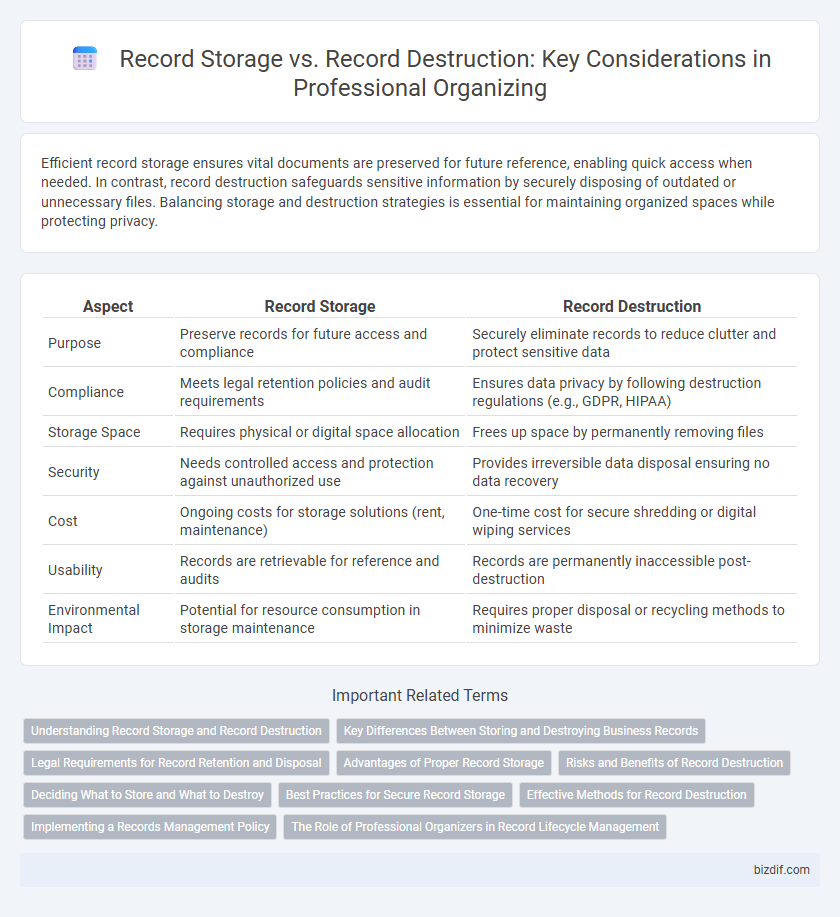Efficient record storage ensures vital documents are preserved for future reference, enabling quick access when needed. In contrast, record destruction safeguards sensitive information by securely disposing of outdated or unnecessary files. Balancing storage and destruction strategies is essential for maintaining organized spaces while protecting privacy.
Table of Comparison
| Aspect | Record Storage | Record Destruction |
|---|---|---|
| Purpose | Preserve records for future access and compliance | Securely eliminate records to reduce clutter and protect sensitive data |
| Compliance | Meets legal retention policies and audit requirements | Ensures data privacy by following destruction regulations (e.g., GDPR, HIPAA) |
| Storage Space | Requires physical or digital space allocation | Frees up space by permanently removing files |
| Security | Needs controlled access and protection against unauthorized use | Provides irreversible data disposal ensuring no data recovery |
| Cost | Ongoing costs for storage solutions (rent, maintenance) | One-time cost for secure shredding or digital wiping services |
| Usability | Records are retrievable for reference and audits | Records are permanently inaccessible post-destruction |
| Environmental Impact | Potential for resource consumption in storage maintenance | Requires proper disposal or recycling methods to minimize waste |
Understanding Record Storage and Record Destruction
Effective professional organizing requires a clear understanding of record storage versus record destruction to maintain compliance and optimize space. Record storage involves securely preserving documents for future reference, typically guided by legal retention policies and organizational needs. Record destruction ensures the safe, permanent disposal of outdated or unnecessary records to protect sensitive information and reduce clutter.
Key Differences Between Storing and Destroying Business Records
Storing business records involves secure, organized retention of documents for legal compliance, future reference, and operational efficiency, ensuring accessibility and protection against loss or damage. Record destruction entails the systematic, confidential elimination of obsolete or sensitive information, reducing storage costs and mitigating risks of data breaches or unauthorized access. Key differences include the purpose of retention versus disposal, compliance requirements, and security measures employed during both processes.
Legal Requirements for Record Retention and Disposal
Legal requirements for record retention and disposal vary by industry and jurisdiction, mandating specific time frames for maintaining documents such as tax records, employment files, and contracts. Professional organizers must ensure compliance by securely storing records during the retention period and implementing proper destruction methods, such as shredding or digital wiping, once the retention time expires. Failure to follow these regulations can result in legal penalties, data breaches, and compromised client confidentiality.
Advantages of Proper Record Storage
Proper record storage ensures the preservation of important documents, facilitating easy retrieval and compliance with legal and regulatory requirements. It minimizes the risk of data loss or damage, protecting sensitive information from unauthorized access or environmental hazards. Efficient storage systems also enhance workplace productivity by reducing clutter and streamlining information management.
Risks and Benefits of Record Destruction
Record destruction reduces the risk of data breaches by securely eliminating sensitive information, ensuring compliance with data protection regulations such as GDPR and HIPAA. Properly documented destruction processes prevent legal liabilities and mitigate the potential misuse of outdated or confidential records. However, premature destruction can result in loss of critical business data and hinder audit or legal reviews, making it essential to balance retention policies with security needs.
Deciding What to Store and What to Destroy
Evaluate documents based on legal requirements, sentimental value, and frequency of use to determine whether to store or destroy records. Financial statements, tax returns, and contracts generally require longer retention periods, while outdated bills and duplicates may be safely recycled. Implementing a clear system for categorizing records minimizes clutter and enhances efficiency in professional organizing.
Best Practices for Secure Record Storage
Secure record storage involves using fireproof, waterproof containers and digital encryption to protect sensitive information from physical and cyber threats. Establishing clear retention schedules ensures records are kept only as long as legally required, reducing unnecessary clutter and minimizing security risks. Regular audits and controlled access protocols prevent unauthorized use and maintain the integrity of stored records.
Effective Methods for Record Destruction
Effective methods for record destruction include shredding, pulverizing, and incineration, each ensuring sensitive information is irretrievably destroyed. Professional organizers emphasize choosing record destruction techniques that comply with industry standards such as HIPAA and GDPR to maintain confidentiality and legal compliance. Incorporating secure document disposal services enhances the overall record management strategy by preventing identity theft and data breaches.
Implementing a Records Management Policy
Implementing a records management policy ensures clear guidelines for distinguishing between record storage and record destruction based on legal retention requirements and organizational needs. Proper classification and secure storage of essential documents reduce clutter while facilitating easy retrieval and compliance. Establishing regular audits and destruction schedules prevents data overload and mitigates risks related to outdated or sensitive information.
The Role of Professional Organizers in Record Lifecycle Management
Professional organizers play a critical role in record lifecycle management by efficiently categorizing documents for either secure storage or timely destruction based on compliance requirements and client needs. They implement systematic assessment protocols to identify records that must be retained for legal, financial, or operational purposes while ensuring obsolete or sensitive information is properly disposed of. Through expertise in regulatory standards and security practices, professional organizers help optimize space utilization, enhance data confidentiality, and mitigate risks associated with improper record handling.
record storage vs record destruction Infographic

 bizdif.com
bizdif.com